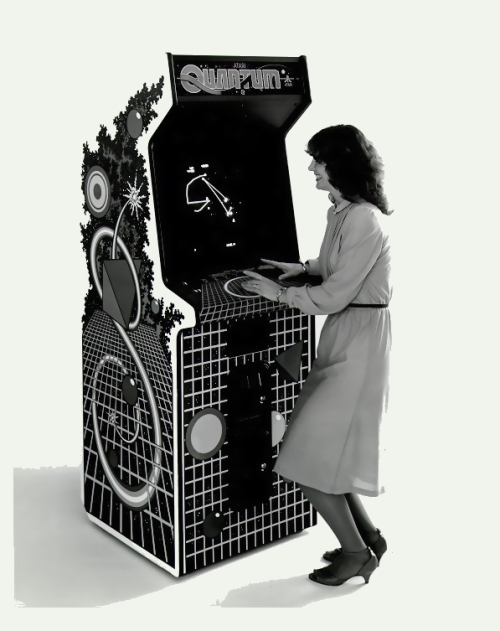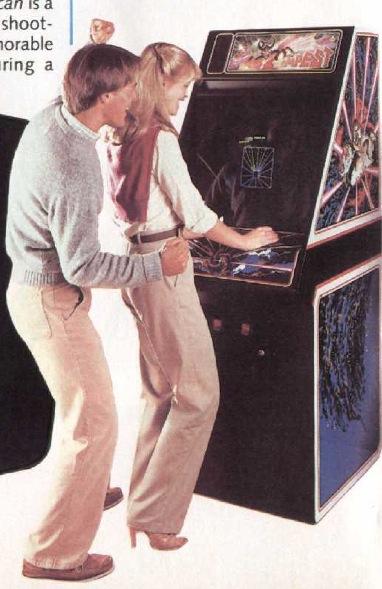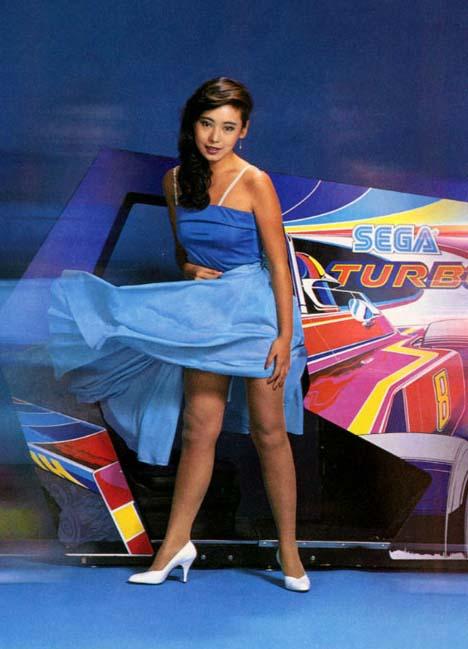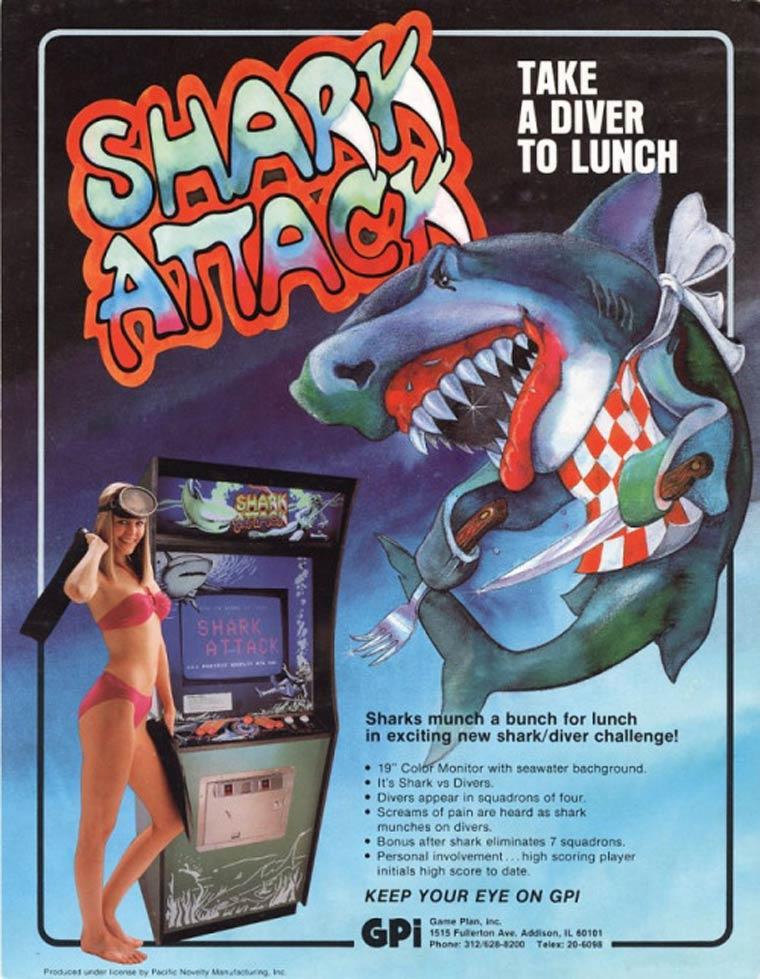Sex - the seller of classic arcade games. And who is the buyer?
- Transfer
As I recall, in the 70s-80s, the slogan “sex is the engine of advertising” was incredibly attractive. There was a feeling that the image of a half-dressed beauty, which is enough to put in front of a certain product and photograph, was the subject of a general agreement in advertising, after which this product would scatter like hot cakes. This concerned jeans, aftershave, cars, and anything else, generously seasoned with ambiguous images designed to pull money from the pockets of alpha males. Somewhere this technique was used subtlely and elegantly, somewhere - more roughly, perhaps, you can find a variety of examples.
Advertising arcade game machines, at least in the early period of their existence, could not resist this trend. The games were then perceived as male entertainment, so the idea that women's images would make their advertising more effective seemed obvious. However, an objective view of what happened then speaks about the ambiguity of the results of such advertising campaigns.
It all started with Computer Space. Perhaps the best place to start our conversation is with her, since she was represented by the first slot machine, which became widespread. Automatic released in 1971, the company Nutting Associates. Then it was clearly felt that in order to sell this game, you need a bit of glamor. As a result, the game industry, from the very beginning, resorted to the services of female models in order to attract the attention of the audience.

Looking into the past, and knowing about that time, I can assume that this approach to advertising was doing its job. The attractive curves of the case of the apparatus were well combined with the model standing next to it.
Similarly, everything happened with future releases of classic arcade games. But, unfortunately, unlike the previous example, the creators of the next snapshot did not seem to think much about it. You can disregard the copies of the screen, videos, demonstrating the course of the game, exciting graphics. Probably just taking a picture of a strictly dressed lady playing a game? Such a move should work. True?

Well, actually, it hardly works. Just compare Computer Space and Quantum ads. I do not want to offend anyone, but using the model dressed as a bookkeeper to “warm up” the Quantum arcade machine, in my opinion, is not the best marketing idea of Atari. Maybe this is a coincidence, but maybe not, but the main release of the game did not take place. A retrospective look is a wonderful thing.
I don’t want to seem like a wild pervert or something like that (I’ll have to write something about it, so wait a minute), but in my opinion, one can argue with the statement that in the case of Centipede the advertisers did better.

In the picture you can see a model with a hairstyle in the style of the 80s, dressed in short fitting shorts. They are perhaps too short. What is there not to like? Although it is not interesting to note that the gaming machine itself is almost completely hidden in the dark? Obviously, he is in this frame - not the most important thing.
At the same time, a more traditional approach to advertising the same game is shown below.


Is everything all right with this ad? Looking at these pictures, I'm not sure that the model will be able to stand in this position for more than five minutes, and, in general, I can turn a blind eye to the fact that the machine is not connected to the power grid. These images are taken from one interesting article about women in gaming rooms, which you can read here .
But, of course, despite my criticism, it should be noted that it is generally accepted that women can be attracted to some games, like Pac-Man from Namco or the same Centipede from Atari (which is interesting, the game Centipede was designed and programmed mainly by Dona Bailey). For example, here's Kate Pearson from the group The B-52s playing in Centipede.


In many Atari promotional materials there are lively couples playing together arcade games. Perhaps such images carry a subtle hint that games are not only a new toy for young men, which fear those who have already matured, but something that absolutely everyone can enjoy. Here you can feel the attempt to "demystify" these early arcade machines. As an example, take a look at the ads for Asteroids Deluxe, Dig Dug, Space Duel, Tempest, Gravitar and Millipede.






As you can see, as long as the model is wearing long pants, the devices are advertised as entertainment for the whole family. On each of these images, the woman, so to speak, at the helm, and the man acts as a passenger, giving the driver advice. This, in the light of the neglect of women in the 70-80s, looks unexpected.
Rewind the tape a few years ago and take a look at Gotcha - one of the early Atari games. Here used a similar approach to shooting. It is said that this picture gave the company a lot of trouble due to its ambiguous overtones. And like - nothing like that - just a guy chasing a girl.

However, if you look at this picture, it turns out that the controllers built into the machine resemble the female breast - a naive attempt to make the game more feminine. After that, you can already understand - how much will be twice two. What is done with the game under the pretext of simply attracting the attention of the audience, can be perceived as something much more base. Here you can see the marketing tricks in which the game with a limited gameplay is wrapped, perhaps created to shock the audience. (You will be pleased to know that Atari removed these ambiguous controllers in later releases of the game, replacing them with a more traditional double joystick).
But advertising Atari machines, released earlier in the 70s. These pictures show inept attempts to use female beauty to promote games such as Pong, Barrel Pong, Space Race and Gran Track 10.


In the two previous images, by the way, the same model.


It seems that here we see samples of the high fashion of the 70s. Following Arari, similar ads were prepared in Sega / Gremlin for the games Fonz, Astro Fighter and Head On, released around the same time.



Is it twins or ancient photoshop? I think we will never know about it, but the flowers in the hands of the models definitely add chic to what is happening in this picture.
The phenomenon of advertising games, which we are talking about here, has not bypassed Sega Japan. Namely, we are talking about the games Monaco GP and the game Space Odyssey.



What about Williams Electronics? Here is the same story. Here is a photo of the Defender machine gun released in 1981.

Here, it seems, everything is fine - as long as it fails to notice that the model is not shod. Frank hint, nothing to say. And here is another interesting observation about this frame. The pictures put on the machine are inspired by Star Wars. They were quickly changed after legal claims from the 20th Century Fox film studio. True, a number of such machines, made before their mass release, yet, after the first exhibitions, went on sale. Today, one or two of these are in collectors.
But what kind of advertising for Shark Attack did in Game Plan in 1981.


Bikini? Check mark. Mask and flippers? Another tick. Subtext in the image of the jaws and a woman in danger? And yet - a reason for male jokes in the center of the second picture. Yes, all this is there. The company Game Plan, shortly after the release of this game, went under the water without a trace.
But variations on the theme of models in short shorts from Stern - an advertisement for the 1981 Moon War game.

And the truth: “The Ultimate Moon Shot”. (Beavis and Butthead laugh out loud).
We have seen a lot of things today, but perhaps the most terrible sinner of the gaming industry is to recognize Konami. Namely, we are talking about the games of the late 1980s: Haunted Castle, Contra, Jungle King, Konami GT, Dead Eye, A-Jax, Missing in Action and Konami Spy. It seems that nothing limited the imagination of their advertisers.








Incredible sexism. Konami can only wish good luck, although her position is still strong.
But advertising Pac-Man, in which, as it seems to me, everything is done correctly. I do not know, however, the official is a snapshot in circulation, or not.

Finally, we have a picture in front of which everything is fine with shoes.
In fact, there are many more examples of the phenomenon that we discussed today. You can find them at The Arcade Flyer Archive .

Advertising arcade game machines, at least in the early period of their existence, could not resist this trend. The games were then perceived as male entertainment, so the idea that women's images would make their advertising more effective seemed obvious. However, an objective view of what happened then speaks about the ambiguity of the results of such advertising campaigns.
It all started with Computer Space. Perhaps the best place to start our conversation is with her, since she was represented by the first slot machine, which became widespread. Automatic released in 1971, the company Nutting Associates. Then it was clearly felt that in order to sell this game, you need a bit of glamor. As a result, the game industry, from the very beginning, resorted to the services of female models in order to attract the attention of the audience.

Looking into the past, and knowing about that time, I can assume that this approach to advertising was doing its job. The attractive curves of the case of the apparatus were well combined with the model standing next to it.
Similarly, everything happened with future releases of classic arcade games. But, unfortunately, unlike the previous example, the creators of the next snapshot did not seem to think much about it. You can disregard the copies of the screen, videos, demonstrating the course of the game, exciting graphics. Probably just taking a picture of a strictly dressed lady playing a game? Such a move should work. True?

Well, actually, it hardly works. Just compare Computer Space and Quantum ads. I do not want to offend anyone, but using the model dressed as a bookkeeper to “warm up” the Quantum arcade machine, in my opinion, is not the best marketing idea of Atari. Maybe this is a coincidence, but maybe not, but the main release of the game did not take place. A retrospective look is a wonderful thing.
I don’t want to seem like a wild pervert or something like that (I’ll have to write something about it, so wait a minute), but in my opinion, one can argue with the statement that in the case of Centipede the advertisers did better.

In the picture you can see a model with a hairstyle in the style of the 80s, dressed in short fitting shorts. They are perhaps too short. What is there not to like? Although it is not interesting to note that the gaming machine itself is almost completely hidden in the dark? Obviously, he is in this frame - not the most important thing.
At the same time, a more traditional approach to advertising the same game is shown below.


Is everything all right with this ad? Looking at these pictures, I'm not sure that the model will be able to stand in this position for more than five minutes, and, in general, I can turn a blind eye to the fact that the machine is not connected to the power grid. These images are taken from one interesting article about women in gaming rooms, which you can read here .
But, of course, despite my criticism, it should be noted that it is generally accepted that women can be attracted to some games, like Pac-Man from Namco or the same Centipede from Atari (which is interesting, the game Centipede was designed and programmed mainly by Dona Bailey). For example, here's Kate Pearson from the group The B-52s playing in Centipede.


In many Atari promotional materials there are lively couples playing together arcade games. Perhaps such images carry a subtle hint that games are not only a new toy for young men, which fear those who have already matured, but something that absolutely everyone can enjoy. Here you can feel the attempt to "demystify" these early arcade machines. As an example, take a look at the ads for Asteroids Deluxe, Dig Dug, Space Duel, Tempest, Gravitar and Millipede.






As you can see, as long as the model is wearing long pants, the devices are advertised as entertainment for the whole family. On each of these images, the woman, so to speak, at the helm, and the man acts as a passenger, giving the driver advice. This, in the light of the neglect of women in the 70-80s, looks unexpected.
Rewind the tape a few years ago and take a look at Gotcha - one of the early Atari games. Here used a similar approach to shooting. It is said that this picture gave the company a lot of trouble due to its ambiguous overtones. And like - nothing like that - just a guy chasing a girl.

However, if you look at this picture, it turns out that the controllers built into the machine resemble the female breast - a naive attempt to make the game more feminine. After that, you can already understand - how much will be twice two. What is done with the game under the pretext of simply attracting the attention of the audience, can be perceived as something much more base. Here you can see the marketing tricks in which the game with a limited gameplay is wrapped, perhaps created to shock the audience. (You will be pleased to know that Atari removed these ambiguous controllers in later releases of the game, replacing them with a more traditional double joystick).
But advertising Atari machines, released earlier in the 70s. These pictures show inept attempts to use female beauty to promote games such as Pong, Barrel Pong, Space Race and Gran Track 10.


In the two previous images, by the way, the same model.


It seems that here we see samples of the high fashion of the 70s. Following Arari, similar ads were prepared in Sega / Gremlin for the games Fonz, Astro Fighter and Head On, released around the same time.



Is it twins or ancient photoshop? I think we will never know about it, but the flowers in the hands of the models definitely add chic to what is happening in this picture.
The phenomenon of advertising games, which we are talking about here, has not bypassed Sega Japan. Namely, we are talking about the games Monaco GP and the game Space Odyssey.



What about Williams Electronics? Here is the same story. Here is a photo of the Defender machine gun released in 1981.

Here, it seems, everything is fine - as long as it fails to notice that the model is not shod. Frank hint, nothing to say. And here is another interesting observation about this frame. The pictures put on the machine are inspired by Star Wars. They were quickly changed after legal claims from the 20th Century Fox film studio. True, a number of such machines, made before their mass release, yet, after the first exhibitions, went on sale. Today, one or two of these are in collectors.
But what kind of advertising for Shark Attack did in Game Plan in 1981.


Bikini? Check mark. Mask and flippers? Another tick. Subtext in the image of the jaws and a woman in danger? And yet - a reason for male jokes in the center of the second picture. Yes, all this is there. The company Game Plan, shortly after the release of this game, went under the water without a trace.
But variations on the theme of models in short shorts from Stern - an advertisement for the 1981 Moon War game.

And the truth: “The Ultimate Moon Shot”. (Beavis and Butthead laugh out loud).
We have seen a lot of things today, but perhaps the most terrible sinner of the gaming industry is to recognize Konami. Namely, we are talking about the games of the late 1980s: Haunted Castle, Contra, Jungle King, Konami GT, Dead Eye, A-Jax, Missing in Action and Konami Spy. It seems that nothing limited the imagination of their advertisers.








Incredible sexism. Konami can only wish good luck, although her position is still strong.
But advertising Pac-Man, in which, as it seems to me, everything is done correctly. I do not know, however, the official is a snapshot in circulation, or not.

Finally, we have a picture in front of which everything is fine with shoes.
In fact, there are many more examples of the phenomenon that we discussed today. You can find them at The Arcade Flyer Archive .

